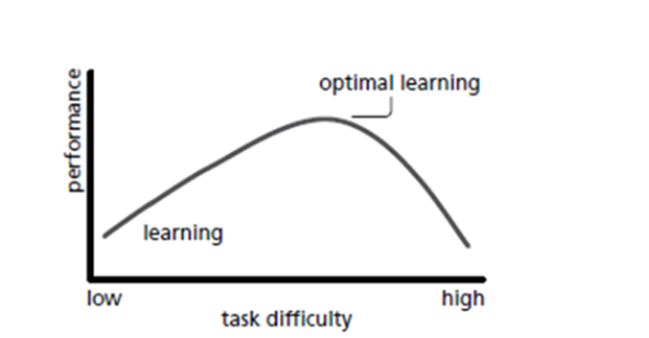Learning requires a challenge (Challenge Point)
For effective learning, the right level of challenge must be found. Maximum training success is achieved with optimal difficulty and complexity of a task. The difficulty of the task must also be individually tailored to the student's level of performance.
Content
The Challenge Point model was formulated by Professor Mark Guadagnoli in 2006 and states that effective learning must always present the right level of challenge . According to it, there is an optimal difficulty and complexity of an exercise task for maximum exercise success. The difficulty of this task must also be individually tailored to the individual learner. Task difficulty refers to all internal and external aspects of a learning task , such as
complexity of the task,
the required accuracy or speed,
load variability,
the complexity of his feedback
interference with other tasks to be performed.
Optimal learning difficulty
The model starts from the premise that information must always be processed during a learning process and that the quantity and quality of this information determine the success of learning. If the information is too little or too simple, then the learning system is not sufficiently stimulated. If, on the other hand, there is too much information or too complex, then the learning system is overloaded. The optimal task difficulty always lies somewhere in the middle and should in principle be readjusted for each new learning task. The amount of information that can be processed during learning varies greatly from person to person and depends, on the one hand, on the level of performance of the learner. On the other hand, it also depends on the capacity of the working memory , which must filter and sort the information received.

Additionally, the challenge point model emphasizes that the optimal learning success point is not the immediate learning success point, see the chapter on " The Learning Illusion ". Typically, more complex tasks are initially learned in fragments and only later assembled into a coherent global solution. Rest or sleep phases also play an important role in this process. Learning processes have been shown to be severely hindered when sleep is suppressed. It is assumed that the brain further consolidates the information accumulated during resting phases and then transfers it from working memory to long-term memory.
These considerations also have consequences for learning in heterogeneous groups, as is normally the case in school classrooms, for example. Each child should have the opportunity to practice with tasks set according to their optimal individual learning difficulty.
What does this mean for my teaching practice?
In school classes, each child should be able to practice at the optimal learning difficulty individually adapted. Therefore, tasks should be designed in an open-ended way, so that different levels of learning are possible during task solving and to avoid under- or over-challenging. This is easier to do in playful tasks or in group work where different children can take on different roles.
Reflection question
For one area of your lesson, think about how a task could be set so that as many children as possible can practise at their individually favourable learning level.
Quiz
1) The point about optimal learning success is a question of
A) as many learning successes as possible
B) frequent failure
C) a challenge
2) How should the exercises be adapted with increasing competence?
A) always the same level
B) less practice time
C) increasingly difficult